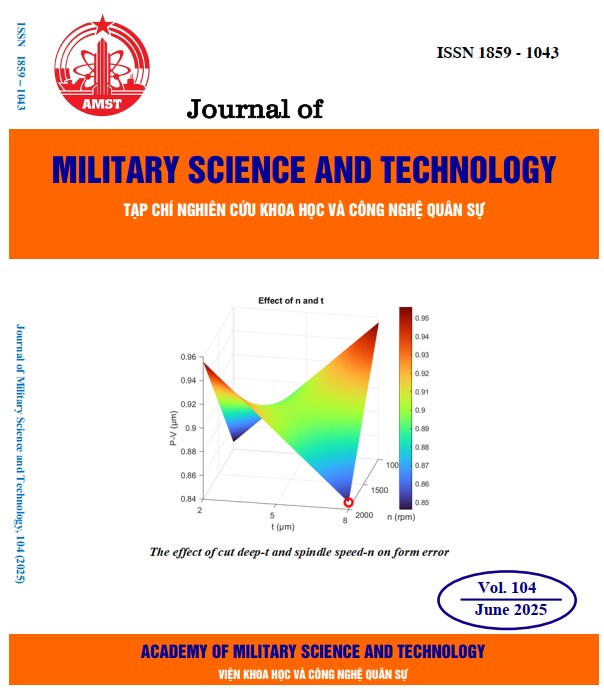Synthesis and structural characterization of CoMn₂O₄ binary metal oxide from metal-organic frameworks
324 viewsDOI:
https://doi.org/10.54939/1859-1043.j.mst.104.2025.79-86Keywords:
CoMn2O4; Metal-organic framework; XRD; EDX; FTIR; SEM; BET.Abstract
The CoMn₂O₄ binary metal oxide with a spinel structure was synthesized from metal-organic framework (MOF) prepared using both microwave-assisted and hydrothermal methods. The time to synthesize MOF by hydrothermal method is much longer than that of the microwave-assisted method. Synthesized materials were characterized by X-ray diffraction (XRD), fourier-transform infrared spectroscopy (FT-IR), scanning electron microscopy (SEM), and Brunauer-Emmett-Teller (BET) surface area. The results showed that the CoMn₂O₄ oxide had high purity and a spherical nanocrystalline morphology with particle sizes ranging from 30 nm to 50 nm. Notably, the specific surface area of the material derived from MOF synthesized using the microwave-assisted method reaches 92,40 m²/g, significantly higher than that of the material synthesized by the hydrothermal method, which is 61,84 m²/g This demonstrates that the microwave-assisted method not only reduces synthesis time but also enhances the specific surface area of the material, which is a crucial factor for applications in catalysis, energy storage, and environmental treatment.
References
[1]. Gonçalves J. M. et al., “ Multifunctional spinel MnCo2O4 based materials for energy storage and conversion: A review on emerging trends, recent developments and future perspectives”, Journal of Materials Chemistry A, 9 (6), (2020). DOI: https://doi.org/10.1039/D0TA11129E
[2]. Suresh R. et al., “Recent advancements of spinel ferrite based binary nanocomposite photocatalysts in wastewater treatment”, Chemosphere, 274, 129734, (2021).
[3]. Gonçalves J. M. et al., “Feasible strategies to promote the sensing performances of spinel Mco2O4 (M = Ni, Fe, Mn, Cu and Zn) based electrochemical sensors: a review”, Journal of Materials Chemistry C., 9, pp. 7852 - 7887, (2021). DOI: https://doi.org/10.1039/D1TC01550H
[4]. Yadav et al., “Polypropylene Nanocomposite Filled with Spinel Ferrite NiFe2O4 Nanoparticles and In-Situ Thermally-Reduced Graphene Oxide for Electromagnetic Interference Shielding Application”, Nanomaterials, 9(4), 621, (2019). DOI: https://doi.org/10.3390/nano9040621
[5]. Q. Zhao et al., "Spinels: Controlled Preparation, Oxygen Reduction/Evolution Reaction Application, and Beyond", Chem. Rev., 117, pp. 10121 - 10211, (2017). DOI: https://doi.org/10.1021/acs.chemrev.7b00051
[6]. J. Zhao et al., “Spinel ZnMn2O4 nanoplate assemblies fabricated via “escape-by-crafty-scheme” strategy”, Journal of Materials Chemistry, 22, pp. 13328-13333, (2012). DOI: https://doi.org/10.1039/c2jm32261g
[7]. Suresh R. et al., “Recent advancements of spinel ferrite based binary nanocomposite photocatalysts in wastewater treatment”, Chemosphere, 274, 129734, (2021). DOI: https://doi.org/10.1016/j.chemosphere.2021.129734
[8]. Lai Y.J. et al., "Solid mediator Z-scheme heterojunction photocatalysis for pollutant oxidation in water: Principles and synthesis perspectives", Journal of the Taiwan Institute of Chemical Engineers, 125, pp. 88 - 114, (2021). DOI: https://doi.org/10.1016/j.jtice.2021.05.049
[9]. Saha S. et al., "A review on the heterostructure nanomaterials for supercapacitor application", Journal of Energy Storage, 17, pp. 181 - 202, (2018). DOI: https://doi.org/10.1016/j.est.2018.03.006
[10]. T. Zeng et al., "Spatial Confinement of a Co3O4 Catalyst in Hollow Metal-Organic Frameworks as a Nanoreactor for Improved Degradation of Organic Pollutants", Environmental Science & Technology, 49, pp. 2350 - 2357, (2015). DOI: https://doi.org/10.1021/es505014z
[11]. P. Hu et al., "Cobalt-catalyzed sulfate radical-based advanced oxidation: A review on heterogeneous catalysts and applications", Applied Catalysis B-Environmental, 181, pp. 103 - 117, (2016). DOI: https://doi.org/10.1016/j.apcatb.2015.07.024
[12]. H. Liang et al., "Excellent performance of mesoporous Co3O4/MnO2 nanoparticles in heterogeneous activation of peroxymonosulfate for phenol degradation in aqueous solutions", Applied Catalysis B-Environmental, 127, pp. 330-335, (2012). DOI: https://doi.org/10.1016/j.apcatb.2012.09.001
[13]. Y. Yao et al., "Sulfate radicals induced from peroxymonosulfate by cobalt manganese oxides (CoxMn3-xO4) for Fenton-Like reaction in water". Journal of Hazardous Materials, 296, pp. 128-137, (2015). DOI: https://doi.org/10.1016/j.jhazmat.2015.04.014
[14]. Hosseini S. A. et al., "Chemical-physical properties of spinel CoMn2O4 nano-powders and catalytic activity in the 2-propanol and toluene combustion: Effect of the preparation method", Journal of Environmental Science and Health, Part A, 46(3), pp. 291 - 297, (2011). DOI: https://doi.org/10.1080/10934529.2011.539093
[15]. Lin C. et al., "CoMn2O4 Catalyst Prepared Using the Sol-Gel Method for the Activation of Peroxymonosulfate and Degradation of UV Filter 2-Phenylbenzimidazole-5-sulfonic Acid (PBSA)", Nanomaterials, 9(5), 774, (2019). DOI: https://doi.org/10.3390/nano9050774
[16]. Abel M. J. et al., "Investigation on structural, optical and photocatalytic activity of CoMn2O4 nanoparticles prepared via simple co-precipitation method”, Physica B Condensed Matter, 601(4), 412349, (2020). DOI: https://doi.org/10.1016/j.physb.2020.412349
[17]. John Abel M. et al., “Facile synthesis of solar light active spinel nickel manganite (NiMn2O4) by co-precipitation route for photocatalytic application”, Research on Chemical Intermediates, 46 (27), (2020). DOI: https://doi.org/10.1007/s11164-020-04159-y
[18]. Li Y. et al., “Novel hollow microspheres MnxCo3-xO4 (x = 1, 2) with remarkable performance for low-temperature selective catalytic reduction of NO with NH3”, Journal of Sol-Gel Science and Technology, 81(2), pp. 576 - 585, (2016). DOI: https://doi.org/10.1007/s10971-016-4208-8
[19]. Masoomi M. Y. et al., "Mixed‐Metal MOFs: Unique Opportunities in Metal–Organic Framework (MOF) Functionality and Design", Angewandte Chemie, 131(43), pp. 15330 - 15347, (2019). DOI: https://doi.org/10.1002/ange.201902229
[20]. Hessamaddin Sohrabi et al., "Metal-organic frameworks (MOF)-based sensors for detection of toxic gases: A review of current status and future prospects", Materials Chemistry and Physics, 299, 127512, (2023). DOI: https://doi.org/10.1016/j.matchemphys.2023.127512
[21]. Yuxia Xu et al., "Metal organic frameworks and their composites for supercapacitor application", Journal of Energy Storage, 56 (A), 105819, (2022). DOI: https://doi.org/10.1016/j.est.2022.105819
[22]. Qian Su et al., "Research progress of MOF-based materials in the photocatalytic CO2 reduction", Carbon Resources Conversion, 7 (1), 100211, (2024). DOI: https://doi.org/10.1016/j.crcon.2023.100211
[23]. Lin R. B. et al.,.. “Microporous Metal-Organic Framework Materials for Gas Separation”, Chem, 6 (2), pp. 337 - 363, (2019). DOI: https://doi.org/10.1016/j.chempr.2019.10.012
[24]. Linyan Yang et al., "Bimetal-Organic Framework-Derived CoMn@C Catalysts for Fischer-Tropsch Synthesis", Catalysts, 13(3), 633, (2023). DOI: https://doi.org/10.3390/catal13030633
[25]. Li C. X. et al., "Metal organic framework-derived CoMn2O4 catalyst for heterogeneous activation of peroxymonosulfate and sulfanilamide degradation", Chemical Engineering Journal, 337, pp. 101 - 109, (2018). DOI: https://doi.org/10.1016/j.cej.2017.12.069
[26]. Zhao J. et al., "Gas-solid two-phase flow (GSF) mechanochemical synthesis of dual-metal–organic frameworks and research on electrochemical properties", Nanoscale Advances, 2(12), pp. 5682 - 5687, (2020). DOI: https://doi.org/10.1039/D0NA00749H







